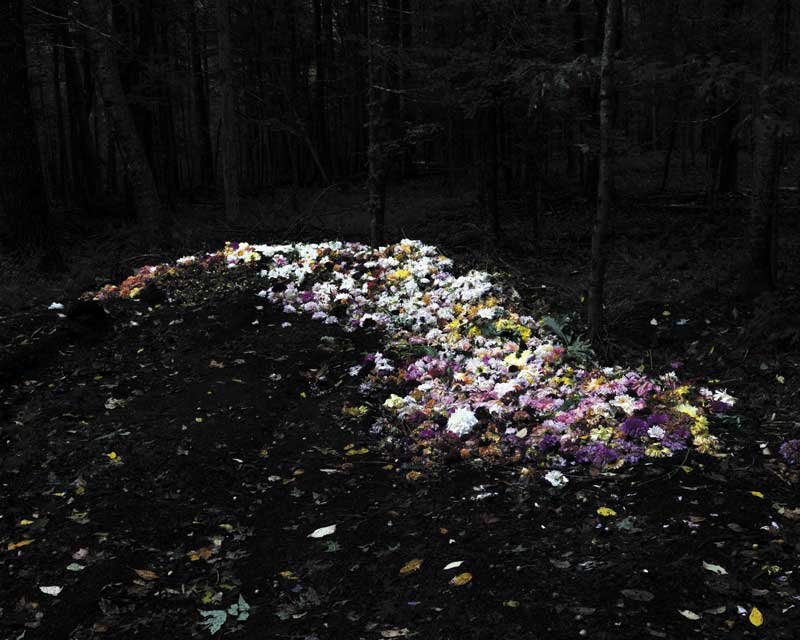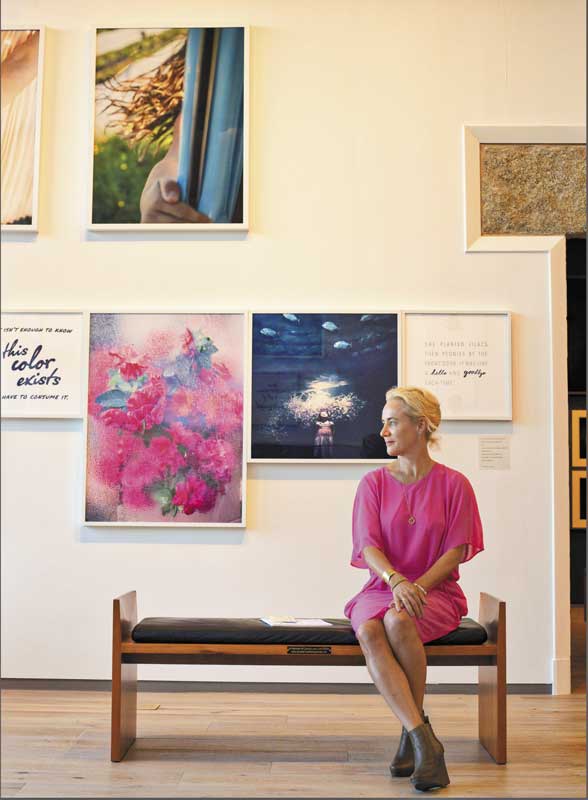Cig Harvey
Turning small moments into times of wonder
All photographs from Blue Violet (2021), courtesy of the artist

In the spring of the first year of the pandemic, photographer Cig Harvey recalled that she and many others were desperate for something to brighten their lives. “We were all out doing our daily walk, watching the plants move by the millimeter, right?” In retrospect, Harvey wonders if people had ever paid so much attention to the minutiae in daily life.
One of Harvey’s responses to the bleakness was to cut a bunch of forsythia and force it. She filled a bathtub in her home in Rockport, Maine, with sprays of the bush and ran the water. On the second or third morning, she opened the door and gasped: The flowers had come out overnight, filling the space with a brilliant glow. “It was like something was in the room, yellow coming out,” she said. She knew it was going to make a good picture because her young daughter Scout “took a gasp too, which is a good sign.”
The photograph appeared in the New York Times on April 24, 2020, in a feature about how photographers were dealing with isolation. Surely newspaper readers felt similar sensations—joy and hope—at Harvey’s subject and smiled at the setting. One imagines some of them followed her lead and lit up their interiors with blossoming branches.
Harvey’s star has been rising fast in the art photography world. She had her first solo museum show at the Stenersen Museum in Oslo in 2012 in conjunction with the release of the first of four monographs, You Look At Me Like An Emergency. Her work has been featured in Vogue, The Wall Street Journal, Vice, and other major publications, and has been acquired by the Museum of Fine Arts in Houston and Boston, the Farnsworth Art Museum, and the International Museum of Photography and Film at the George Eastman House in Rochester, New York. She was named the Prix Virginia Laureate, an international photography award based in Paris. In 2018 the Ogunquit Museum of American Art hosted a mid-career retrospective.
In another act of bringing light into a dark world, in November 2020, Harvey started projecting large-scale images at night onto a large blank wall in downtown Rockport. “Covid numbers were on the surge and it was the week before the election,” she remembers, “and it was just feeling so angry and dark—it was getting dark at 3:30, physically dark.”
 Cig Harvey, High Tide, North Haven
A series of 50-foot photographs, aphoristic poems, and motion pieces played on a continuous loop every night through March 2021. “I intended to surprise commuters on the drive home from work with a giant projection of hot pink flowers or an image of fire-orange ranunculus filling the grey concrete wall,” Harvey said. One of her projected poems reminded passersby to “inhale ocean / exhale sky.”
Cig Harvey, High Tide, North Haven
A series of 50-foot photographs, aphoristic poems, and motion pieces played on a continuous loop every night through March 2021. “I intended to surprise commuters on the drive home from work with a giant projection of hot pink flowers or an image of fire-orange ranunculus filling the grey concrete wall,” Harvey said. One of her projected poems reminded passersby to “inhale ocean / exhale sky.”
The images and words came from Harvey’s book, Blue Violet, the fourth in a series of remarkable collections of her photographs and writings. She had been working on it for three years, and in an unforeseen twist, Covid-19 helped her cross the finish line by providing her with extra time to work on it. She will always think of it as her “pandemic book.”
While Harvey calls Blue Violet a “compendium of flowers,” she insists it is not about flowers, but rather “about living and dying.” At the same time, like her other books, the featured work appeals to the senses, with flowers used as metaphor and symbol to access what it is to be human.
The book grew out of a sad situation. One of Harvey’s close friends had leukemia and was undergoing treatment in Boston. Among other hospital constraints, she wasn’t allowed fresh flowers. “Everything had to be Purell’ed, all the food was sealed and scorched in a microwave. Her sensory experiences became more and more limited,” Harvey recounted.
The woman asked Harvey to send her pictures. It was summertime, so she sent “riotous pictures of just Maine doing its best.” When her friend asked for more, Blue Violet began to take shape. The photographer subsequently researched all things floral. “Recipes, lists, folklore, historical significance of flowers within art and the secret language of flowers: It was just a well to dive into.”
 Cig Harvey, Scout & the Disco Ball
Cig Harvey, Scout & the Disco Ball
Harvey calls herself a “huge supporter, appreciator, admirer of beauty,” and she wants more of it in the world. To that end, her photographs not only bring about gasps, they convey an otherworldly splendor, be it apples encased in ice or a virtual sea of dark petunias. When figures appear, they reinforce the wonder. A woman in a red dress does a solo dance among seaweed in the waters off North Haven. Sometimes it’s just a hand proffering a flower or a vase of blossoms.
Harvey’s daughter, Scout, now 10, has made regular appearances in the photographs, an image at once of innocence and experience. In one Blue Violet photo, she holds a disco ball in her arms, the mirrored orb creating constellations on a nearby barn wall.
Asked how she chooses a subject, Harvey said it’s more about paying attention. She thinks of the camera as a kind of Ouija board that leads her to things. A lot of time is spent looking and then asking herself, “Why did I love that river? Why did I photograph that person? Why am I drawn to that landscape?” She depends on intuition and an extraordinary eye for what she calls the rare in the world.
 Cig Harvey, Frozen Apples
Even when a photograph is constructed, such as when she meets someone at a location at a particular time of day, there’s “a bunch of magic that happens.” The weather changes, sometimes the unplanned happens. She carries a camera with her every day and tries to stop and take a picture of something that for some reason drew her in. If she only constructed pictures, her world, she said, “would get smaller.”
Cig Harvey, Frozen Apples
Even when a photograph is constructed, such as when she meets someone at a location at a particular time of day, there’s “a bunch of magic that happens.” The weather changes, sometimes the unplanned happens. She carries a camera with her every day and tries to stop and take a picture of something that for some reason drew her in. If she only constructed pictures, her world, she said, “would get smaller.”
Harvey doesn’t have to go far: Many of her photographs come from perambulations near her Maine home. On a day this past May she paid her annual visit to the School House apple orchard in Warren. “It’s like Eden—you can’t even believe it,” she said of the gnarly trees in full bloom; “It feels so lucky to be alive when you’re in amongst them.” Returning a few days later, the blossoms were gone. “But what a great metaphor for life, right? To appreciate, slow down….”
 Cig Harvey, The Compost Heap
Cig Harvey, The Compost Heap
Harvey’s work is typically driven by the story and narrative the photographs provoke. “I don’t sit in my studio and say, ‘and now I’m going to make a project about this, this, or this.’” For her, the magic happens when there are a lot of unknowns.
With all of her books, writing is half of the ingredients. Harvey describes her vignettes of “the small things in every day” as part of an ongoing “gratitude journal,” giving thanks for everything in the world that surprises and is rare, “what you thought needed to be appreciated.” She writes every day and then extensively refines her words for publication.
The writing is often as startling as the photography. Here’s a sample that highlights her love of color and brilliantly employs cross-outs: “The only thing I like about the hardware store is the paint swatches. You can leave me in that department for hours. A Pantone book is my morning news. I love this but does it make me seem ignorant? A Pantone book is my beach read. No, I feel too serious about color for this. A Pantone book is my War and Peace. (War and Peace is too boring.) A dog-eared Pantone book sits on my nightstand.”
Born in the county of Devon in Southwest England in 1973, Harvey took up photography in her teens. She loved the darkroom—and still does, vowing to return to it one day. She remembers the alchemy of developing film: “You’re listening to your favorite music, the light is moody with red, and you’re making something appear out of nothing.”
Today, Harvey shoots primarily digital, which is less constraining than film, although both have their advantages and disadvantages. She never looks at the photos she’s just taken in the back of the camera; she always lets a day go by before she starts to edit the work. If an image interests her, she’ll print it and put it up on the wall—a process not unlike her darkroom practice.
Harvey came to Maine sight unseen in September 1999 to attend the year-long program at Maine Photographic Workshops. She studied with photographer Brenton Hamilton, went on to earn her master’s degree there, and began teaching.
In 2002 Harvey was offered an adjunct professor position at the Art Institute of Boston, part of Leslie University. She left Maine to teach full-time for the next 10 years, but the die had been cast: During that decade away, she spent nearly every weekend in Maine. She and her husband eventually bought a house in Rockport in 2007.
Harvey is part of the core faculty for the Maine Media Workshops’ MFA program and leads workshops around the world. She teaches to share her love of the art and the different methodologies she uses in her own work. “I want to be open about the way I practice, live my life through my artwork.” She also loves the company: “A lot of art-making is quite solitary, and I like to laugh. There’s a camaraderie of like-minded souls in teaching.”
In 2017 Harvey was awarded the Excellence in Teaching Award from CENTER, an international organization that honors, supports, and provides opportunities for gifted and committed photographers. The year 2017 also brought a special opportunity: to join a group of photographers for an immersive visit to Cuba. Harvey’s first love was street shooting, so she embraced this return to her photographic roots. “Cameras give us such an opportunity to bear witness but also give you license to walk up to someone and say, ‘tell me about yourself.’” The trip was filmed and made into a documentary, Return to Cuba: In the Footsteps of Walker Evans.
On a grim day in March of that same year, Harvey drove to Bangor to join 27 people from 24 different countries to swear allegiance to America. She had been living on a visa for 30 years and wanted, among other things, to be the same nationality as her daughter. In what was “a tricky time” in this country, she found the ceremony powerful and beautiful and moving; “I cried my eyes out.”
Someone recently asked Harvey if she thought she’d ever go back to England to live. “And I said, ‘Absolutely not.’ I really feel American.” In the next breath she admits it’s not so much America, “It’s really Maine.” Her adopted home is an intrinsic part of her art. What is more, she feels like a Mainer.
 Cig Harvey at her solo show at the Ogunquit Museum of American Art, summer 2018. Photo by Alissa Hessler
This past summer, Harvey’s artistic contributions to her adopted state were recognized by the Farnsworth Art Museum which presented her with a Maine in America Award, one of “13 Women of Vision” to receive the annual honor. She joined an illustrious group that included Louise Nevelson, Katherine Bradford, Marguerite Zorach, and Edna St. Vincent Millay.
Cig Harvey at her solo show at the Ogunquit Museum of American Art, summer 2018. Photo by Alissa Hessler
This past summer, Harvey’s artistic contributions to her adopted state were recognized by the Farnsworth Art Museum which presented her with a Maine in America Award, one of “13 Women of Vision” to receive the annual honor. She joined an illustrious group that included Louise Nevelson, Katherine Bradford, Marguerite Zorach, and Edna St. Vincent Millay.
Asked about the goal of her work, Harvey puts aside some of the labels, like “magic realist,” that have been applied to her. “My work is very much grounded in reality,” she said. While she loves Photoshop, that’s not what she does: “I have to find it in the world. That’s my job: to get up at 5 a.m. and see that light or find that landscape that makes me gasp.”
Harvey will continue to rely on instinct. “It’s kind of wonderful after all these years to be surprised and be blind-sided by something that you assumed would be one way,” she said. “I think that’s the gift of creativity and that’s the gift of art.”
Carl Little lives and writes on Mount Desert Island. He is a regular contributor to this magazine and to Working Waterfront, Art New England, and Hyperallergic.
✮
Harvey is represented by Dowling Walsh Gallery in Rockland, Robert Mann Gallery in New York, Huxley Parlour Gallery in London, Robert Klein Gallery in Boston, Jackson Fine Art in Atlanta, Galleria del Cembalo in Rome, Photo-eye Gallery in Santa Fe, and Kopeikin Gallery in Los Angeles. In the fall of 2021 she will release a limited edition artist book Eat Flowers with Two Ponds Press. You can see more of her work at www.cigharvey.com.
Related Articles
Share this article:
2023 Maine Boat & Home Show

Join Us for the Maine Boat & Home Show!
Art, Artisans, Food, Fun & Boats, Boats, Boats
August 11 - 13, 2023 | On the waterfront, Rockland, Maine
Click here to pre-order your tickets.
Show is produced by Maine Boats, Homes & Harbors magazine.















